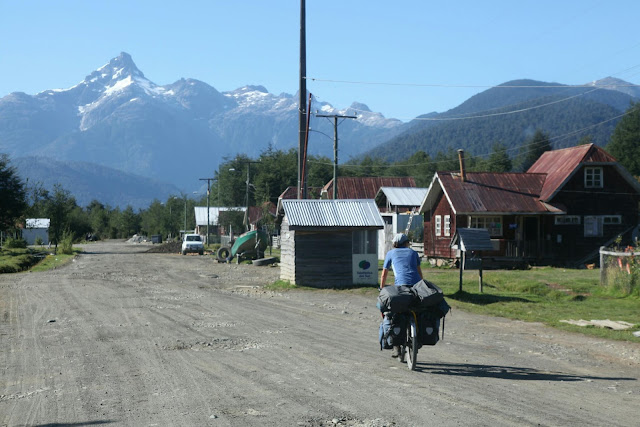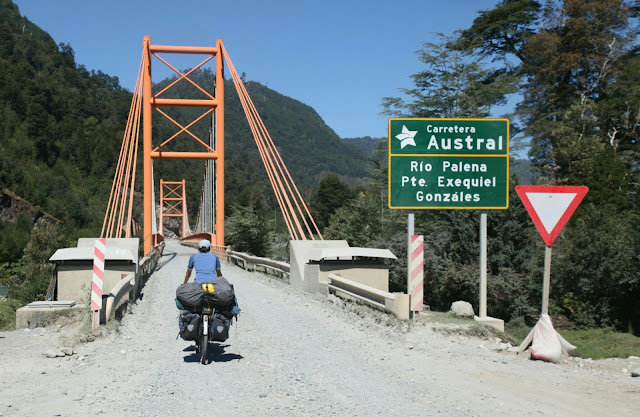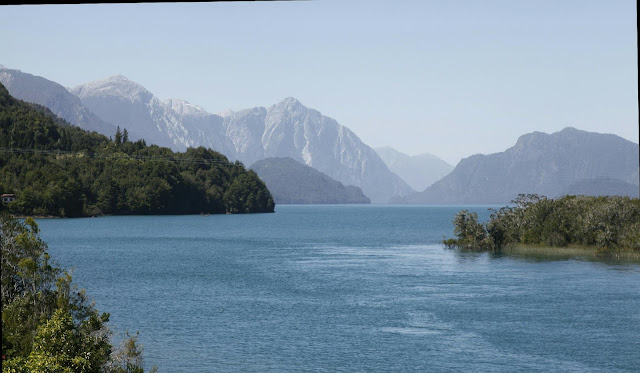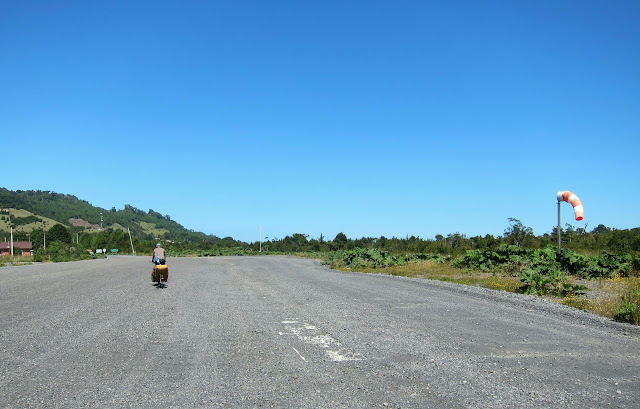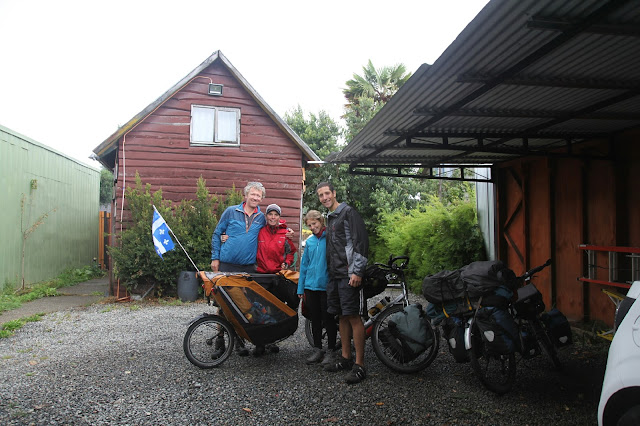Alongside almost every forested road here in Patagonia, you can spot the beautiful red and blue flowers (there are many other less common colour combinations) of Fuchsia Megallanica, competing with the invasive blackberry brambles mistakenly brought here by the Germans to make hedges to protect land. What's really interesting is that it is more regularly known as the Hummingbird Fuchsia and it's amazingly common to see beautiful little hummingbirds hovering next to you supping on nectar as you sit near a shady hedgerow. At first when we saw them out of the corner of our eye in Ralun we thought they were large insects and then looked more carefully. They seem completely unafraid, like many of the birds here, perhaps protected by their speed and agility. Leo loves picking the little flowers if they hang low enough and walks around with them for hours clutching proudly to his little treasures.
24/02/2014
23/02/2014
We need a rest - thank you Coyhaique
The only problem is that with such amazing scenery around us we've actually forgotten to have a rest. We're now completely knackered having cycled about 750km of the Carretera Austral with no breaks over the last 16 days, me pulling about 65kg of trailer, Leo and luggage, and Isa another 35kg, nearly all of it on dirt and gravel roads which really takes its toll. One 32km section before La Junta was perhaps the worse road we have ridden on in 37,000km all over the world. A fellow Dutch cyclist with around 50,000km under his belt voted it the worst he'd seen. It was hell, with big sharp slippy rocks, corrugations and loads of dust. Most cyclists seem to have hitch-biked to avoid it, we just didn't get the opportunity as it's hard to wait for a lift in hot sun, on a quiet road, with an energetic Leo. It just seemed easier to cycle. Then just after it finished we had the 600m climb up 19 hairpin bends, averaging 8% gradient, to really rub it in.
It crept up on us, one minute we were fine, the next we were aching and exhausted, desperate to reach Coyhaique, the only major town for hundreds of km, and to gorge ourselves on protein and be as lazy as Leo allows us. Now we are here we've done nothing, just shopped for food and taken it in turns to sleep. We've also eaten tins of fish and made burgers. YEAH!!!
Leo also seems happy with the new lazy routine, his new games are putting coins in bottles, or collecting flowers from the lovely gardens around our cozy cabaña. 'Tranquillo com una taza de leche', as the Chileans say about a good baby.
A devastated landscape
20/02/2014
Tout Terrain Trailer Review
17/02/2014
How can this get more beautiful?
We are told by everyone we meet that the Carretera Austral route gets better the further South you go. We find this hard to imagine as the scenery is astonishing in almost every direction and we are only about half way along the road.
There's no bad ripio, there's just bad speeds.
'Ripio' or dirt roads are the one topic that always makes its way into conversation with every cyclist or driver that we meet. Everyone wants the latest update on the conditions ahead, 'Is it badly corrugated?'; 'Are the rocks big?'; 'How bad is the dust?'; 'Is there much volcanic grit in it?; 'Is there much traffic?'; 'Are their any road works?'; 'Are there any asphalt sections?'.
We're beginning to realise that the conversation is a pointless one. Everybody has a different perspective:
People with two wheel trailers hate pot holes, car drivers know nothing about the road however well meaning they are, cyclists in a hurry hate it all, and people going North think each new day's road is worse than yesterday's. If you are tired or hungry it's all terrible, or if you expected a flat road and got a climb instead it's definitely a bad surface! Sometimes we meet people who have flown in to an area and just started, they think it's all hell and look shell-shocked.
We've just started trundling along, it's a bit like bumbling. The road is what it is. If it's bad we go slow, but every really bad bit gets better, in the same way that the smooth asphalt eventually finishes. We're very lucky because we don't have a timetable, we don't have to be anywhere on a particular day, we can just ride until we're bored of it, or we see a great view.
Why should the road surface even matter?
Wilderness begins
We turned a corner and all of a sudden it was different. The Valdivian rain forest was gone, the valleys bigger and the mountains more majestic. Now there are wild places, the fences are mostly gone and the gates open, there are choices of rivers to camp next to or swim in. Houses are empty or ruined, a legacy of times past, with the remnants of orchards providing tasty treats if we spot them. Bad roads feel like they are taking us towards more excitement rather than more bumps. This is good but a little troubling. Progress south might stall for a while with great campsites and views every few km.
We don't know what happened.
13/02/2014
First breakage
The steel mount for my handlebar bag broke the other day, 35,000 km isn't bad, especially when the bag is definitely overloaded with a heavy SLR, a tablet and assorted junk and we are riding on really poor dirt roads. Leo has been riding with his feet on it in the trailer but yesterday we found a friendly old guy who welded it back together for £3. I wonder what will be next?
Chaiten's airport
This might need upgrading a little! The road was about 5 times wider for no obvious reason, and then we saw the wind sock.
New things that amuse Leo
Licking his plate (he just copied his mother)
Parque Pumalin
Seeing double
12/02/2014
Chile´s wealth distribution
10/02/2014
The Careterra Austral
Finally we're on this great road. It's hard, the dirt surface ranges from great to terrible, and in some places is even tar, but the surroundings are amazing, and they're only going to get better. Tomorrow a ferry to the next section and then hundreds of km of wilderness with small towns dotted along the way. Can't wait.
09/02/2014
The new Patagonian pioneers
07/02/2014
Goodbye and thankyou to Sergio, Claudia and Diego
These lovely people rescued us from being drowned by constant rain, made us welcome in their home, fed us lovely food and fresh bread, got us drunk, and showed us a little bit of their fascinating life and their plans for the future. We so hope we get to see them again, especially when they build their house and Sergio invents something else that the whole of Patagonia won't be able to live without. We miss them already. Claudia was Leo's first crush and he had a huge smile and started clapping when he saw a photo of her today! Kindred spirits in this crazy world.
05/02/2014
04/02/2014
Leo videos in Chile
On a day visit with Claudia and Sergio to visit Pepe and Caro's amazing place in the forest, Leo showed everyone 'rice power' Leo loved throwing stones into Lago Riñihue, an area like a warm Scotland. He is naked because it is warm enough despite the poor weather.Because of the rain we had to buy wellies for Leo. He became obsessed with them and has spent the last few days carrying them to the back door of Sergio and Claudia's waiting to be let out and play in the rain.The pleasure of wading became taking on deeper and deeper challenges. Leo learned very quickly what to do on a slide. The way children learn stuff so quickly is amazing.
01/02/2014
Teledata.cl and the recolonisation of rural Patagonia

A university friend of Sergio's called Diego who has moved South from Santiago explained to me how he uses software and Google Earth to work out the best locations to put towers, as their system relies on direct line of sight and even tree coverage can affect this. Diego's dream is that their network covers all of rural Patagonia even as far south as Villa O'Higgins! By chance the only place in southern Chile that can galvanise the steel towers that they make is 20 minutes down the road in Puerto Varas. We're sleeping in the small house where they paint the towers and it also serves as a place for the workers to have lunch.



